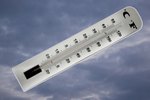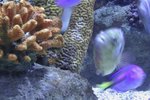Things You'll Need
Type 3 Portland concrete
Play sand
Fine gravel
Rubber gloves
PH testing kit
Non-toxic paint
Rubber mold or plastic container
Making rocks for a fish aquarium allows more creativity in design and is budget-friendly. When making aquarium rock, using non-toxic materials is necessary for the safety of the fish. Creating aquarium rock from a recipe can be accomplished by following simple, but specific directions. Time needed for curing the rocks and testing the aquarium PH level are necessary follow-up steps for the health of the tank.

Type 3 Portland cement can be found at most hardware stores. Mix one part cement and three parts play sand or fine gravel together. The mix should form into a ball and feel like Play-Doh. Wearing gloves is recommended during the mixing process. To create a coral reef look, add additional fine gravel to the mixture. Crushed shells and aragonite sand can also be toxic to fish, and should not be used when making aquarium rock.

Place the rock mold mixture into a plastic container and create openings to allow for swim-through holes.
Rubber or plastic molds can be purchased from a hobby supply store for those who desire a specific rock shape, or any plastic container can be used as a free-form aquarium rock mold.

Let the aquarium rock mixture harden and cure for at least six weeks.

You can paint the aquarium rock after it has sufficiently hardened. Any type of non-toxic paint can be used. Oil-based paints can be toxic to fish and taint the color of aquarium water. Rough edges of any aquarium rock formation should be sanded prior to painting.

Place the aquarium rock in a bathtub or child's pool to allow any excess paint or ingredient chemicals to be washed away. Do not use any type of soap or detergent to clean the rocks.

Use a pH testing kit to monitor the aquarium pH level for at least six weeks after adding the rock. The alkaline content in the water will rise due to the chemical base of the concrete. Placing crushed coral in the aquarium filter will assist with keeping the alkaline level down and enhancing water quality.
Tips
The cost of creating rocks for a large aquarium is approximately $25. Aquarium rock kits can be purchased through many pet store retailers.The price per kit ranges from $30 to $40 but is still less costly than purchasing commercial aquarium rock.
Warnings
Curing of the aquarium rock, and checking pH level are the most important steps in the process. Allowing the pH level to go unchecked can kill the fish and plants in the tank.
This recipe can be used for creating large rock caves. The thicker the rock creation is, the longer the curing process will take. Allow at least eight weeks for hardening when creating an aquarium rock cave.
References
Photo Credits
-
Dale Davidson/Demand Media
Writer Bio
Tara Dodrill began writing professionally in 1990. She is a travel writer and photographer working for print and online media, primarily covering Florida, ecotourism and off-the-beaten-path destinations. Her writing credits include RUMBUM, Yahoo News, Visit South magazine,and North Carolina Coastal Guide. She studied journalism and education at Ohio University and real estate at Hondros College.



